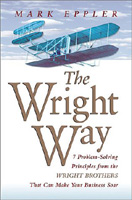 |
| ||||||||||||||||
 |
The Wright Way: 7 Problem-Solving Principles from the Wright Brothers That Can Make Your Business SoarMark Eppler
Excerpt from The Wright Way: 7 Problem-Solving Principles from the Wright Brothers That Can Make Your Business Soar Chapter 1: THE EVENT OF THE CENTURY
"To invent an airplane is nothing. To build one is something. But to fly is everything."It was an odd assortment of men that made the four-mile trek from "Camp Wright" over to Kitty Hawk. One, a lumber dealer from Manteo, had come over to search the rugged Atlantic coast for debris from a recent shipwreck. Hearing talk about a couple of guys planning to fly, he had hung around to "see the show." Three of the group were surfmen from the Kill Devil Hills Lifesaving Station, grizzled veterans of the sea who had befriended the two "odd ducks" from Dayton. The last member was the seventeen year old son of a Nags Head widow who made her way in life telling the fortunes of vacationers for "twenty-five cents a go." Despite their considerable differences, the men had come together that day to form a historic team: the world's first aircraft ground crew. Answering the summons of the Wright brothers to assist them the morning of December 17th, 1903, they had just witnessed the Wright brothers' leap into the pages of history. The Death Of Impossibility Bill Tate, a key figure in the Wright brothers' story at Kitty Hawk, should have been there to see the flight. On the morning of the 17th, Tate stepped outside his home at Martins Point and felt the bite of a Cape Hatteras sting-wind. Combined with the patches of ice forming on the puddles in his yard, Tate was convinced there would be no attempt at flying made that day. Later in the morning he changed his mind, deciding to make the trip over to Kitty Hawk. Near the post office, he saw a small band of men heading his way. As the group neared, the fortune-teller's son couldn't resist telling the Wright brothers' fortune. Johnny Moore broke into a wild run hollering as he went, "They done it! They done it! Damn'd if they ain't flew!" Tate was heartsick. Missing the Wright brothers' first flight would be the regret of his life. Back at the campsite, having just accomplished what man had dreamed of doing since the dawn of civilization, Wilbur and Orville returned to their shelter to warm themselves and enjoy a leisurely meal. They may have just flown, but they were still hungry. Later, eyewitnesses would recall that the brothers didn't seem particularly enthused or excited about what they had done. Perhaps the bitter cold had numbed their excitement. Maybe the first flight "adrenaline rush" had worn off, subduing their spirits. Or, maybe they had expected to fly all along. They were, after all, used to solving problems. A Staggering Event Worn Smooth When the Wright brothers solved the problem of heavier-than-air flight, they not only achieved a technological breakthrough, they stunned the world. It was an incredible achievement with no modern parallel. The only thing that might come close would be if Neil Armstrong had landed on the moon in a craft he had built himself and paid for with a part-time job. To put it into context, consider this. The big news item in the papers the day Wilbur and Orville conquered the air was the story of Colonel H. Nelson Jackson who, in order to win a $50 bet, had driven cross-country in an automobile in the unheard of time of just sixty-three days! The Wright brothers' invention would one day extract 99.8% of the time needed to make Nelson's journey. Wilbur and Orville had redefined the world's concept of time and distance. Unacknowledged Heroes People not only regarded heavier-than-air flight as out of reach, it felt those who tried were deserving of ridicule. Samuel Pierpont Langley, the respected secretary of the Smithsonian Institution who had two embarrassing plunges into the Potomac River to show for his efforts, was hounded by the media. The Boston Herald cruelly suggested he should concentrate his efforts on submarines, not flying machines! An editorial in the New York Times written after Langley's second failure on December 8th, 1903 predicted that manned flight was achievable, but only if scientists and mathematicians worked on it around the clock for the next "one to ten million years." It wouldn't take ten million years. It wouldn't even take ten days. The Giants Had Quit The Wright brothers had methodically and meticulously worked their way through the problem of heavier-than-air, powered and controlled flight, and solved it. The actual flight of Orville wasn't as much the answer to the problem, as it was a confirmation of the process used to achieve it. In solving the problem, the Wright brothers resolved hundreds of smaller challenges which, when taken as a whole, yielded the first flight. For the Wrights, solving the flying problem was a systematic process guided by an established, if not written, set of principles. The first flight was the culmination of that process. That's why the brothers weren't particularly excited or enthused when it occurred. For Wilbur and Orville, the first flight was just another step along a problem-solving continuum. Excerpted from Chapter 1, The Wright Way ” 2004 Mark Eppler. All rights reserved. Published by AMACOM Books. |
|||||||||||||||||||||
|
All prices subject to change and given in U.S. Dollars. |
All materials contained in http://www.LeadershipNow.com are protected by copyright and trademark laws and may not be used for any purpose whatsoever other than private, non-commercial viewing purposes. Derivative works and other unauthorized copying or use of stills, video footage, text or graphics is expressly prohibited. LeadershipNow is a trademark of M2 Communications, LLC. |
